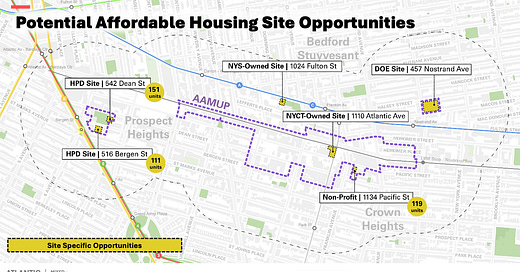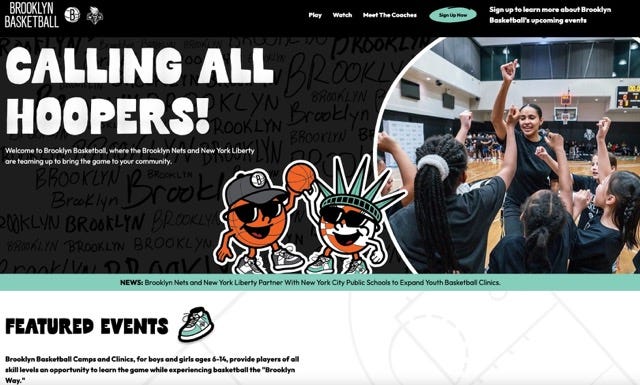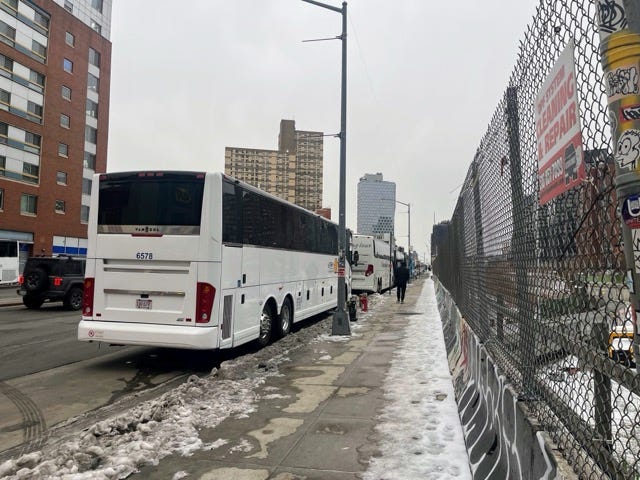Weekly Digest: So Much Is Atlantic Yards-Adjacent
The Atlantic Avenue Mixed-Use Plan moves forward, with issues (affordability, open space, oversight) all influenced by Atlantic Yards. Meanwhile, the Nets' Brooklyn "ecosystem" grows.
This digest offers a way to keep up with my Atlantic Yards/Pacific Park Report blog and my other coverage in this newsletter and elsewhere.
Atlantic Yards/Pacific Park has had a long gestation period, while development in Downtown Brooklyn has proceeded steadily (thanks to a rezoning) and development east of the project site has proceeded in fits and starts (thanks to a series of spot rezonings, see below).
What Brooklyn Community Board 8 began as the M-CROWN initiative has since become the Atlantic Avenue Mixed-Use Plan (AAMUP), which last week I covered for City Limits, in As Atlantic Avenue Mixed-Use Plan Nears Vote, How Much Can Affordability Be Pushed?
The lack of promised affordable housing, the strains on open space, and the failure of oversight with Atlantic Yards/Pacific Park all influence the response to the AAMUP.
No one thinks there would be enough affordable housing, given the displacement (especially of Black residents) in the area and the general need.
That can’t fully be achieved by the city’s Mandatory Inclusionary Housing (MIH) policy, which requires 20% to 30% affordable housing (depending on income level) when such rezonings deliver more buildable floor area.
One way to bolster the numbers is to add such housing at publicly-owned (or nonprofit-owned) sites in the area. Expect 35th District Council Member Crystal Hudson, who is the key decisionmaker when this reaches the Council stage, to push for more commitments.
Is MIH enough?
One important issue, which won’t be resolved with this rezoning, is whether MIH is sufficient. Evidence suggests it’s not, as one-off spot rezonings have achieved better results.
So Brooklyn CB 8 has proposed a new Option 3.5, with more and deeper affordability. While city officials say that’s not possible in this rezoning, nor even on the table, Hudson said it deserves study.
Click through to my article (which has links to the video of a recent hearing by the City Planning Commission) for more, especially when Commissioner Juan Camilo Osorio questions city officials.
The Brooklyn “ecosystem”
I’m keeping my eye on the many-tentacled efforts by BSE Global, the parent company of the Brooklyn Nets, New York Liberty, and Barclays Center operating company, to establish a new “ecosystem” of media, fashion, culture, retail, and events in Brooklyn.
This week I noticed some high-priced merch from the designer Kid Super, featuring Brooklyn Borough President Antonio Reynoso as a model (no, he didn’t keep it).
I also noticed that the youth basketball clinics coming to the shuttered Modell’s store probably will cost a pretty penny.
It all distracts from the arena’s not-so-neighborly takeover of nearby blocks, such as for an un-announced youth basketball tournament.
From City Limits
Feb. 13: As Atlantic Avenue Mixed-Use Plan Nears Vote, How Much Can Affordability Be Pushed?
From this newsletter
No standalone article this week. Too busy! (Stay tuned for much more.)
From Atlantic Yards/Pacific Park Report
Feb. 11: The Brooklyn Way: new Brooklyn Nets merchandise from designer Kid Super includes boost from Borough President Reynoso, modeling $995 leather jacket. No, he didn’t get compensated.
Feb. 12: Will Brooklyn Basketball clinics, when they come to Modell's, cost $575 for five days? That's what they cost elsewhere this summer. (Programs at schools are free.)
Feb. 14: Flashback 2006: what the Atlantic Yards Final Environmental Impact Statement said about the blocks east of Vanderbilt Avenue, now facing a rezoning.
Was it the "uses" that prevented the transformation of a light manufacturing area into a residential area—or, rather, the zoning? Now we have the Atlantic Avenue Mixed-Use Plan. Again, it’s all adjacent.
Feb. 15: Buses line Atlantic Avenue (thanks to NYPD) for un-announced youth basketball event.
The Barclays Center would have it much tougher if towers were built there, since construction would constrain the street and, after opening, residents and commercial tenants would object. It’s a very tight fit (one of my mantras).








